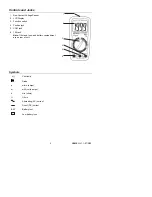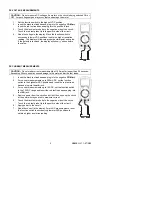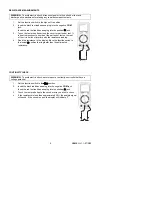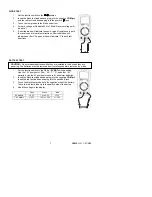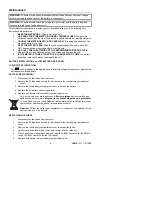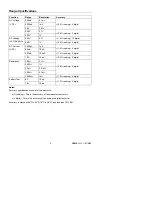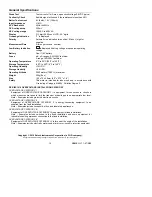
MN42-EU - V1.1 – 07/2010
10
General Specifications
Diode Test
Test current of 1mA max, open circuit voltage 2.8VDC typical.
Continuity Check
Audible signal will sound if the resistance is less than 30
Ω
Batter Test current
9V (6mA); 1.5V (100mA)
Input Impedance
>1M
Ω
ACV Bandwidth
45Hz to 450Hz
DCA voltage drop
200mV
NCV voltage range
100VAC to 600VAC
Display
3 ½ digit, 2000 count LCD, 0.5” digits
Overrange indication
“
1
” is displayed
Polarity
Automatic (no indication for positive); Minus (-) sign for
negative
Measurement Rate
2 times per second, nominal
Low Battery Indication
+
-
is displayed if battery voltage drops below operating
voltage
Battery
One (1) 9V battery
Fuses
mA, µA ranges; 0.2A/250V fast blow
A range; 10A/250V fast blow
Operating Temperature
0ºC to 50ºC (32ºF to 122ºF`)
Storage Temperature
-20
o
C to 60
o
C(-4
o
F to 140
o
F )
Operating Humidity
<70% RH
Storage Humidity
< 80% RH
Operating Altitude
2000 meters (7000 ft.) maximum.
Weight
255g(9 oz )
Size
150 x 70 x 48mm (5.9” x 2.75” x 1.8”)
Safety
This meter is intended for indoor use and in accordance with
Overvoltage Category III-600V, Pollution Degree 2.
PER IEC1010 OVERVOLTAGE INSTALLATION CATEGORY
OVERVOLTAGE CATEGORY I
Equipment of OVERVOLTAGE CATEGORY I is equipment for connection to circuits in
which measures are taken to limit the transient overvoltages to an appropriate low level.
Note – Examples include protected electronic circuits.
OVERVOLTAGE CATEGORY II
Equipment of OVERVOLTAGE CATEGORY II is energy-consuming equipment to be
supplied from the fixed installation.
Note – Examples include household, office, and laboratory appliances.
OVERVOLTAGE CATEGORY III
Equipment of OVERVOLTAGE CATEGORY III is equipment in fixed installations.
Note – Examples include switches in the fixed installation and some equipment for
industrial use with permanent connection to the fixed installation.
OVERVOLTAGE CATEGORY IV
Equipment of OVERVOLTAGE CATEGORY IV is for use at the origin of the installation.
Note – Examples include electricity meters and primary over-current protection equipment
Copyright
©
2010 Extech Instruments Corporation (a FLIR company).
All rights reserved including the right of reproduction in whole or in part in any form.



